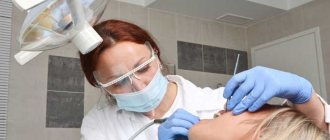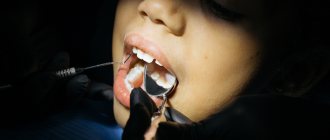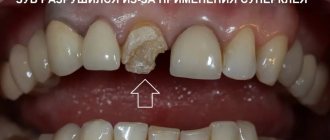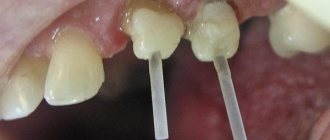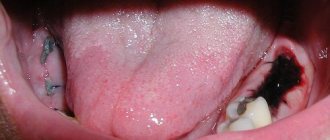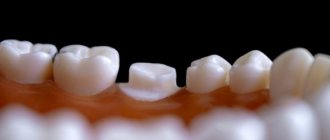Before
After
When there is no trace left of the dental crown, and all the roots are in place, a fair question arises: what to do next? Should this tooth be considered completely lost, or does the presence of the root provide a chance for restoration? Modern dentists, in the fight for every saved tooth, offer several options for solving this problem. The main thing is to make sure that the roots are healthy, there are no cysts, granulomas, inflammatory or carious formations on them.
When is a tooth root 100% subject to extraction?
Tooth root removal is performed if:
- the root is softened below the gum level,
- the root of the tooth is below the level of the surrounding bone tissue,
- the root of the tooth has cracks
:
- the root of the tooth is chipped
:
- the root of the tooth is severely damaged, for example as a result of canal treatment with resorcinol
:
- There are various inflammatory processes around the root and under the root of the tooth - cyst, cystogranuloma
:
- the root of the tooth is mobile,
- there is a deep dental pocket.
Correction with crowns
If the tooth is severely damaged, but the root is not destroyed, correction with crowns is used. The technique is implemented on the front and chewing teeth. Crowns are installed when it is impossible to install a filling - when the carious cavity is too extensive, when the tooth is destroyed by 70% or more.
How to install a crown:
- The tooth is prepared, freed from affected tissue, and the walls are ground down;
- An impression is made and sent to the dental laboratory.
- The finished crown is tried on and installed.
Modern technologies make it possible to obtain crowns that perfectly imitate the transparency, shade and texture of natural teeth.
How is tooth root removal done?
Are there any features or important points when removing a tooth root? Of course, any removal - be it tooth extraction, wisdom tooth removal, impacted tooth or tooth root should be carried out as atraumatically as possible, preserving the tissue structure
that surround a tooth or tooth root:
The goal of atraumatic root removal is to preserve bone
. Removal should be done painlessly.
The clinics of the German Implantology Center are supporters of atraumatic and painless removal. Our technologies have been proven over the years, and our patients feel very comfortable with them. It is no secret that many patients have fears about removal, and these fears sometimes postpone the surgical stage of treatment for a long time. In our clinics, we help patients overcome these fears. The patient may not be afraid of anything - both in the case of a single extraction and in case of multiple extractions of teeth
:
Teeth extension methods
There are 2 main extension methods:
- Straight. Used if tooth decay is up to 30%. During the procedure, composite or photopolymer materials are used to build teeth. The former are less durable and harden after 30 minutes. The latter have a service life of 10 years and remain plastic until exposed to the lamp.
- Indirect. Applicable when damage affects no more than 70% of the structure. The method has several stages, including taking impressions, making and installing ceramic inlays.
If you have ever thought about whether a crown or extension is better, then you should know that a crown is installed when more than 70% of the tissue is destroyed, but a intact and healthy root remains.
What is atraumatic tooth root removal?
What instruments does the surgeon use to achieve atraumaticity? For atraumatic removal, special instruments are used - thin, neat and elastic elevators that can minimally invasively penetrate and expand the periodontal tissue that connects the tooth root directly to the jaw. Using special instruments, the periodontal ligaments are cut so that the root can be removed as carefully as possible, in its “pure form.”
The vestibular plate that surrounds the bone is very thin. And we work with her carefully when removing teeth. It may also be necessary to saw the root of the tooth so that it can be removed in pieces. Sawing can be carried out with oscillating ultrasonic attachments - ultrasonic knives. Cutting the root of a tooth can be done quite effectively with a high-quality thin surgical dental bur, which has a certain length.
After cutting the root, the medial wall of the root is first removed, and then the vestibular wall of the root is removed. This allows for maximum preservation of surrounding tissue.
Then, after such removal, you can preserve the tooth socket or place an implant so that the bone is preserved as much as possible. Preservation of the tooth socket is carried out if there are no conditions for installing an implant at once, or if the patient undergoes delayed implantation.
If the roots of wisdom teeth are removed, the socket is not preserved; it is enough to remove them as atraumatically as possible. Let's talk about this in a little more detail.
Features of root removal of decayed wisdom teeth
Are there any difficulties when removing the roots of wisdom teeth? Removing the roots of wisdom teeth requires that the surgeon has sufficient experience. Often the roots of these third molars (wisdom teeth) are located close to the mandibular canal. Often the roots of molars are adjacent to the upper or lateral wall of the mandibular canal. The configuration of wisdom tooth roots is extremely diverse and sometimes extremely difficult to remove:
Therefore, when removing the roots of wisdom teeth, it is imperative that the patient undergo a CT scan. And the surgeon, as I said, needs to have some experience in surgical training in order to avoid the risks of removing the roots of such teeth and carry out the manipulation as efficiently as possible.
Like any root teeth, the roots of wisdom teeth are removed by cutting them along the roots. Wisdom teeth do not have problems because they are close to the angle of the lower jaw and there are strong cortical plates there. When I talked about thin vestibular walls, this comparison refers to the aesthetic zone of the smile, to the frontal group of teeth, including the premolars:
.
Methods for front and chewing teeth
Depending on the clinical situation, the following methods are used:
- composite art restoration;
- extension on a pin;
- recovery by tabs;
- installation of veneers;
- fixation of crowns.
| Defect | Front tooth | Chewing |
| Small chip | Composite Veneers | Composite |
| A piece of a tooth broke off | Composite Veneers | Composite Tab |
| No half a tooth | On the pin Veneers Crown | On the pin Tab Crown |
| No tooth wall | — | On the pin Crown |
| Destroyed tooth to the root | On the pin Crown | Crown with root strengthening core tab or pin |
| Teeth worn out | Composite Veneers Crown | Composite Tab Crown |
| Gap between teeth | Composite Veneers Crown | — |
What the patient needs to understand before root removal
You need to assess the health risks, you need to talk to the attending surgeon, find out about his experience. Quite often, tooth root removal is carried out, unfortunately, with the following negative consequences:
- gums are torn
- fractured bony vestibular plate
Sometimes when visiting such patients, you get the feeling that the tooth was not removed, but knocked out with something. There were cases when a patient’s extraction began in some clinic, and there, in the middle of the patient’s appointment, the doctor announced that he was unable to remove it, and the patients came to us in this form to remove the root of a tooth that was already in the extraction stage.
When removing the roots of wisdom teeth, you may face risks such as jaw fracture. One of the common risks of removing the roots of 3 molars is damage to the mandibular nerve
, leading to cuts and numbness in areas of the jaw. There is a risk of damaging the artery on the lingual side.
If, when a tooth is removed, a root or part of it is left behind, what should you do?
According to Russian treatment standards, the tooth root cannot be left during extraction. That is, if the patient was left with a root or part of it during removal, then this is considered a poorly performed surgical procedure.
In European countries there are doctors who agree that if there is no inflammation on the tooth and if the root part is not infected, and removal of the root leads to trauma, then only the cortical part of the root is removed, and the other part remains in the bone.
If the patient is left with a part of the root that is infected, then this is a problem. A cyst may develop and inflammation may develop. If the apical part was not infected, then everything heals and does not bring any trouble to the patient.
Tooth root without crown part
Can a tooth root without a crown cause inflammation in the gums or bone? Of course it can. There is a canal at the root of the tooth; if this canal is infected, then the problem will develop into a negative prognosis.
Inflammation, suppuration, periostitis, osteomyelitis - diseases can develop due to an infected tooth root. And the source of infection at the root must be removed; if it is impossible to remove the infection and preserve the root, then it must be removed.
Price
- Primary appointment (examination, consultation) with a dentist (special offer) 100001
For free
Promotion
- Restoring a tooth with a filling (Restoration) 140007
6 900 ₽
- Tooth restoration with filling materials using anchor/fiberglass pins (restoration) 140009
8 900 ₽
- Tooth restoration with inlay (E.max) 152012
19 900 ₽
- Tooth restoration with a crown (E.max) 152013
21 900 ₽
- Tooth restoration with Veneer, Half-crown (E.max) 152014
21 900 ₽
- Tooth restoration with a full zirconium crown 152015
13 900 ₽
- Tooth restoration with a metal-ceramic crown 152019
13 900 ₽
Teeth extension is aimed at restoring their anatomical shape and color. Used for chips, cracks, and changes in enamel shade. Allows you to correct congenital dental anomalies and eliminate interdental gaps. Methods and materials for extensions are selected depending on the type of defect. These can be composite restorations, installation of pins, inlays, veneers or crowns. The chosen option affects the cost of treatment.
Is implantation possible after tooth root removal?
Yes, of course it is possible. And we at the clinics of the German Implantology Center widely use implantation after tooth root removal. Our conditions allow us to carry out implantation in such cases. And if we can achieve primary stability of the implant, then in 90% of cases
After removal, we immediately install the implant. We have rolled out the technology to perfection and gives excellent results.
Of course, with the exception of wisdom teeth, no implant is placed after their removal. But, by the way, wisdom teeth in this situation can be extremely useful, since they... can be transplanted to the place of the problem tooth being removed! Dental transplantation has been practiced in the clinics of the German Implantology Center since 2017, and our specialists have accumulated a wealth of clinical experience. Let's talk about this a little more.
Reasons why only the root remains of a tooth
For clarity, we will divide them into two parts - external and internal.
The first include:
- Injuries (in addition to participation in boxing matches, no less dangerous is the habit of opening lids with your teeth or gnawing hard objects);
- Exposure of enamel to contrasting temperatures (hot after cold and vice versa);
- Chemical factors (for example, the harmful effects of carbonated drinks);
- Lack of proper oral hygiene.
To the second:
- Metabolic disease;
- Lack of vitamins due to poor diet;
- For women - pregnancy.
An alternative to implantation is autotransplantation of wisdom teeth
Don't rush to remove your wisdom teeth. Firstly
, there must be clear indicators for their removal.
Secondly
, you don’t need to follow fashion, trends and delete eights just because “a girlfriend or friend deleted them and it’s cool.” There are a number of moments in life when wisdom teeth come to our aid.
It is not for nothing that nature has created a number of organs that duplicate each other in our body, for example, we have two lungs, two kidneys, which in case of problems with one lung/kidney come to our aid. Also with wisdom teeth: if a person (for some reason) has problems with the chewing group of teeth, for example, caries has destroyed the sixth or seventh tooth, then eights can come to the rescue. How so? After all, wisdom teeth are not involved in the chewing process. Yes, you are right here. But a wisdom tooth can serve as a donor, and it can be transplanted into place of a tooth with destroyed roots. Fantastic? No, advanced technologies in dentistry. This is called autotransplantation.
In the following video we show in detail the dental transplant surgery. The roots of two sixths of the patient's teeth had just been destroyed, and they were replaced by the patient's own wisdom teeth. And, by the way, this patient at the end of the video gives a detailed review after 1 year after the operation. Look, this is useful:
Tooth extension onto a pin
When thinking about whether it is possible to build a tooth onto the root, the use of a pin comes to mind. It is used if both the body and the root are severely damaged.
The procedure includes:
- obtaining an x-ray;
- cleaning the mouth, removing stones;
- removal of damaged areas;
- computer tooth modeling;
- removal of saliva;
- anesthesia;
- cleaning of channels;
- implantation of a pin, cleansing the area around it;
- filling the space around the pin with a composite or photopolymer;
- polishing and grinding.
Dentists build up teeth under crowns only if the remainder is in good condition and does not rot or decompose.
Indications and contraindications for the procedure
Extension is indicated in the following cases:
- Chips and cracks on the tooth surface.
- Destruction of enamel or its discoloration, which cannot be eliminated with bleaching.
- Partial tooth loss due to injury or caries.
- Malocclusion.
- Interdental gaps.
- Age-related wear of enamel, in which the dental unit darkens and becomes sensitive to external influences.
However, restoration is not suitable for every patient. It cannot be performed if one of the contraindications is present:
- Untreated caries or gum disease.
- Severe systemic diseases, such as blood diseases or diabetes.
- Some mental disorders.
- Bruxism.
- Bruxism. Individual intolerance to the components of the filling composite.
There are also technological limitations: if it is impossible to protect the restored surface from contact with moisture (for example, saliva), then the extension will have to be abandoned - the filling will not harden. Also, some methods cannot be used for dental treatment in children - for example, they do not have pins installed. For most patients, augmentation remains the optimal solution for restoring a lost tooth fragment.
What happens if you don’t see a doctor in a timely manner?
If, after much thought about what to do with a decayed tooth, you decide to leave everything as it is, you are seriously risking your health. Damage to the gums can affect neighboring teeth, and pathological changes in soft tissues will not take long to occur. Many people, without thinking about the consequences of their decision, walk around with a tooth destroyed at the very base, believing that they are in no danger: after all, at first glance, there are no changes in their well-being. However, in some cases they may be invisible only at first. If the crown part of the tooth is destroyed, changes can be observed with the naked eye. However, in the case of a root this is not possible. Damage to it can lead to infections. As a result, at a minimum, a person will experience constant bad breath, which is difficult to get rid of, and in more severe cases, plaque and tartar may form, which will gradually spread to neighboring teeth.
If there is an infection, the condition of not only the tooth root, but also the entire oral cavity worsens. Which can negatively affect the state of the microflora of the digestive system as a whole, since pathogenic organisms will be swallowed along with saliva. The immune system will have to expend considerable effort to maintain normal health. In the long term, it is possible to develop sinusitis, inflammation of bone tissue and other serious diseases.
Are modern technologies used when restoring teeth?
A new product that has fundamentally improved the quality of dental restoration is 3D models of dentures. Today, a specialist carries out all the preparatory work on a computer: in a special program he creates a three-dimensional model of the prosthesis, which will subsequently be manufactured on a machine. Thanks to this, the accuracy of work has increased and, accordingly, time for fitting and fitting is saved. Prostheses that are ideal for the patient are manufactured in the clinics of the Unident network without unnecessary visits to the doctor, which distracts the patient from important matters.
Who will have to part with a tooth?
Complications following tooth extraction in the doctor's office are extremely rare. Much more often, sad consequences occur when it spontaneously falls out due to destruction or injury. In such cases, there are two options: restoration of dentin and enamel or removal of the tooth root.
The tooth root will have to be removed if the following symptoms occur:
- constant discomfort in the gums;
- sharp pain when chewing;
- swollen soft tissue;
- bleeding;
- the appearance of pus.
A sure sign of an inflammatory process in the gums is an increase in body temperature in the absence of symptoms of another disease.
Important! You cannot postpone a visit to the dentist, even if only one of these symptoms appears. Any suspicion that the tooth root remains in the gum and has begun to rot should prompt an urgent visit to a doctor.
What are the roots of teeth, look at the photo:
Temporary contraindications
Surgical removal of the root of a decayed tooth is contraindicated during:
- relapse of complex mental disorder;
- acute phase of ARVI;
- exacerbation of neurological disease;
- rehabilitation after a heart attack.
Doctors at dental clinics are aware of all contraindications to extraction. But not all conditions have clear clinical signs, so in order to avoid unpleasant consequences, it is necessary to warn the doctor about the ailment.
